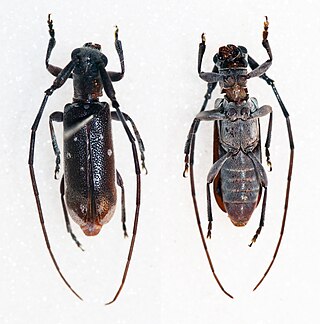"Bufo" scorteccii is a species of toad in the family Bufonidae. It is endemic to Yemen, with its range restricted to a plateau near the western region of Mafhaq. Its natural habitats are shrubland as well as wetland areas.
Atractaspis scorteccii, commonly known as Scortecci's mole viper or the Somali burrowing asp, is a species of venomous snake in the family Atractaspididae.
Rhinotyphlops scorteccii, commonly known as Scortecci's blind snake, is a species of snake in the family Typhlopidae. The species is endemic to Somalia.
Gobius scorteccii is a species of freshwater goby native to Somalia, Africa. This species can reach a length of 13.6 centimetres (5.4 in) TL. The specific name honours the Italian herpetologist Giuseppe Scortecci (1898-1973) of the University of Genoa, who was the collector of the type.

Eunidia is a genus of longhorn beetles of the subfamily Lamiinae.
Eunidia fallaciosa is a species of beetle in the family Cerambycidae. It was described by Stephan von Breuning in 1939. It is known from Somalia.
Eunidia flavoapicata is a species of beetle in the family Cerambycidae. It was described by Stephan von Breuning in 1939.
Eunidia fuscostictica is a species of beetle in the family Cerambycidae. It was described by Stephan von Breuning in 1939.
Eunidia jeanneli is a species of beetle in the family Cerambycidae. It was described by Breuning in 1939. It is known from Tanzania, Somalia, Kenya, Zimbabwe, and South Africa.
Eunidia spilotoides is a species of beetle in the family Cerambycidae. It was described by Stephan von Breuning in 1939.
Eunidia albolineata is a species of beetle in the family Cerambycidae. It was described by Stephan von Breuning in 1959.
Eunidia quadrivittata is a species of beetle in the family Cerambycidae. It was described by Stephan von Breuning in 1938. It is known from Kenya and Somalia.
Eunidia subannulicornis is a species of beetle in the family Cerambycidae. It was described by Stephan von Breuning in 1968.
Microeurydemus semivittatus is a species of leaf beetle. It is distributed in Somalia, Saudi Arabia and Yemen. It was first described by Martin Jacoby in 1899.

Eunidia thomseni is a species of beetle in the family Cerambycidae. It was described by William Lucas Distant in 1898. It is known from Tanzania, Cameroon, Chad, Niger, Ethiopia, Senegal, Mozambique, Botswana, Namibia, Saudi Arabia, the Central African Republic, Somalia, Uganda, South Africa, Yemen, Kenya, and Zimbabwe.
Scortecci's dwarf gecko is a species of lizard in the family Gekkonidae. The species is native to East Africa.
Scortecci's sand gecko, also known commonly as Scortecci's dwarf gecko, is a species of lizard in the family Gekkonidae. The species is endemic to the Arabian Peninsula.
Heliobolus spekii, also known commonly as Speke's sand lizard, is a species of lizard in the family Lacertidae. The species is native to East Africa and the Horn of Africa. There are three recognized subspecies.
Latastia doriai, also known commonly as Doria's long-tailed lizard, is a species of lizard in the family Lacertidae. The species is endemic to the Horn of Africa. There are three recognized subspecies.
Platyceps scortecci is a species of snake of the family Colubridae.

